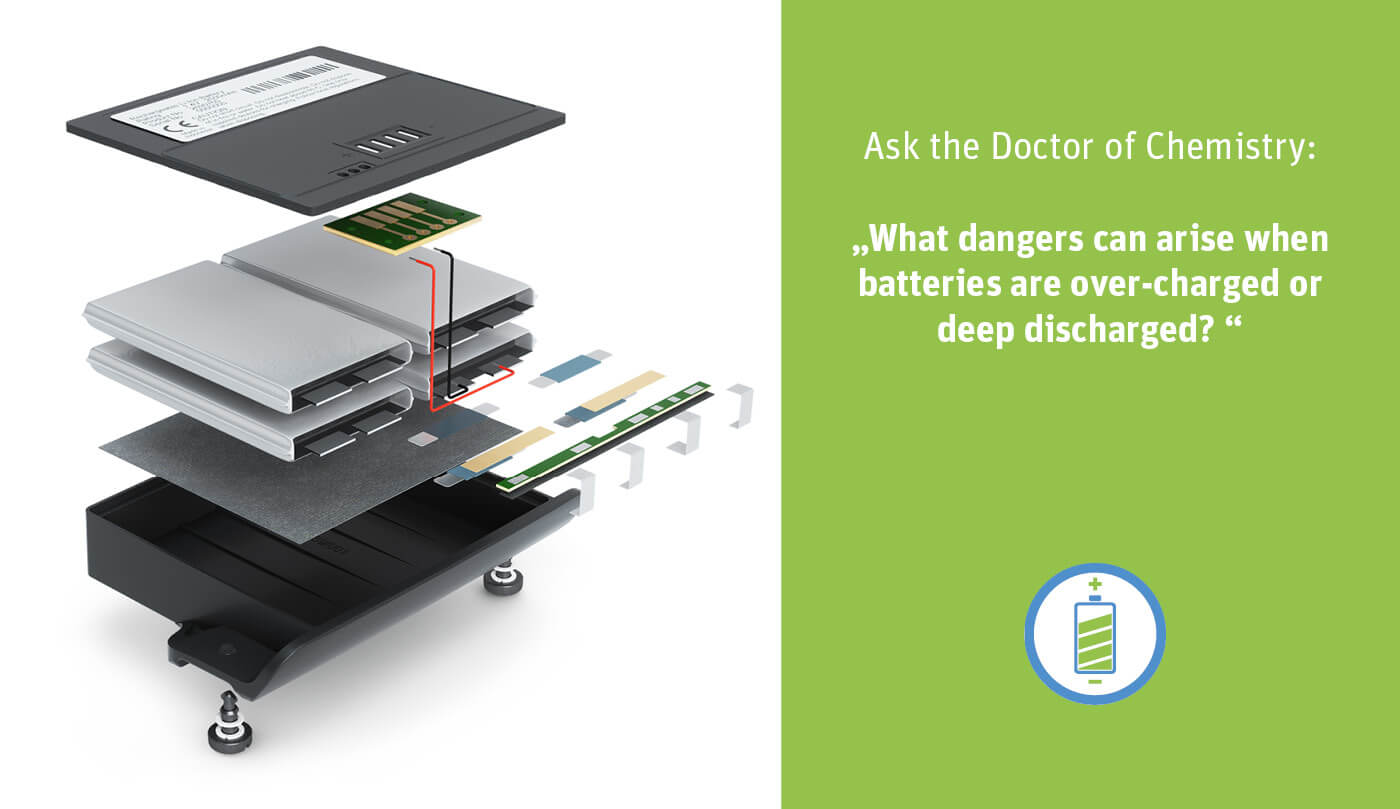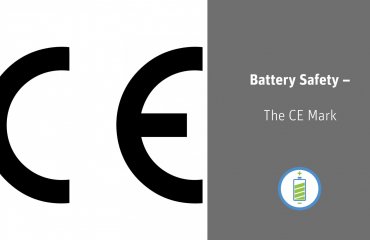
Charging Process:
Lithium-batteries are charged with constant current until a voltage of 4.2 V is reached at the cells. Next, the voltage is kept constant, and charging continues for a certain time. The charger then switches off further charging either after a preset time or when a minimum current is reached. In the rare event that the charger does not switch off, for example continues to allow the charging current to flow, there is an electronic protection circuit and possibly a passive safety element located on the cell. These protective mechanisms ensure the safety of the user. But what dangers can arise when batteries are over-charged or deep discharged?
In order to operate lithium-batteries safely and optimize their life span, they should not be over-charged or deep discharged.
What happens when a battery is over-charged?
If neither the charger nor the protection circuit stops the charging process, then more and more energy enters the cell. As a result, the voltage in the cell rises – this is known as over-charging. On the one hand, this is harmful to the battery and bad for its life span. On the other hand, it can pose a safety risk for the user. The excess energy leads to heat generation. “In the worst case, this can lead to a so-called ‘thermal runaway’. This means that the temperature in the cell continues to rise and chemical reactions start from it, which proceed exponentially. These reactions can no longer be stopped,” explains Dr. Jürgen Heydecke. In the case of lithium-batteries, this can lead to the cell opening and possibly burning down. “With lithium-polymer batteries, it should also be noted that gas formation can occur in the cell, which leads to the severe swelling of the cell.” The next step would also be thermal runaway and, thus, burnout.”
And what about deep discharge?
This is referred to when the cell voltage drops significantly below the cut-off voltage. In itself, this phenomenon does not lead to any safety problems. However, it slowly destroys the cell’s performance, which can also cause the battery to swell under certain circumstances.
“If a battery does become deeply discharged, special care must be taken during the subsequent recharge. With the aid of very low current, an attempt must be made to rebuild the basic voltage so that charging can then resume normally from 3 V,” says Heydecke.
Key take-away:
Users must therefore ensure that suitable chargers are used and to avoid damaging the devices and batteries. This ensures that the protective mechanisms can take effect in an emergency and prevents the dangers that can arise especially when lithium-batteries are overcharged.
More from our “Ask the Doctor of Chemistry” series:
What special features are there to consider when designing-in a lithium polymer cell?


 Deutsch
Deutsch 




wow, great post! …
Nice Work!!
Great Post!!
Nice Efforts!!!!
best and effective
my lithion ion battery on solar went completely down red light on. can i damage the battery
Hi Martie,
thank you for your question. We recommend to directly contact the manufacturer.
Best regards
Selina
Do Battery Management Systems help to mitigate these situations? I’ve also heard that some lithium-ion batteries can be discharged to such a low state of charge that they can’t be recharged again (even if they’re relatively new). Is that true?
Hello Phil,
thank you for your questions.
A BMS definitely helps to mitigate these situations, because overcharging or deep discharging is avoided as far as possible. However, if lithium batteries are not charged and left for a long time, they can still be pulled into deep discharge because the BMS also has a quiescent current. We recommend to always keep applications charged to avoid deep discharge.
Hope this helps 🙂
Kind regards
Selina
Hey, this blog gives me a basic idea of Li batteries like overcharging or deep discharging, it was simple and easy to understand. Thank you
Hello John,
thank you very much for this feedback. We’re happy that the article helped you.
Best regards
Selina
Hi, keep up the great work!
I have some brand new batteries that seems to have been deep discharged. How would you recommend trying to bring them back up to a chargeable voltage?
They are part of a wireless BT headset and are
really tiny and really difficult to replace.
Hi Kyle,
thank you for your feedback and question.
I spoke to one of our experts and the recommendation is that you try to charge the application with supplied charger. It is very important that it is the supplied charger, because it may be that it recognizes the low voltage and uses the small charging currents that are necessary to reach the basic voltage. It could take a few hours until you see something. However, if the LED is not lit after a few hours the battery is too damaged and must be replaced.
Hope this helps.
Best regards
Selina
Hello, I have a new 45ah CMAX bank that I use for competitive car audio and electronics. Max charge voltage recommended is 16.8v. Unfortunately I left the bank on my bench and forgot that I was charging it and by the time I got back to it the voltage was 17.6v. I hooked up a couple computer fans to the bank to slowly draw the voltage down overnight and this morning the bank sits at 16.3v. I plan to continue the draw until it’s at a safe operating voltage for my car at 15.8v. The bank is showing no swelling of the cells or signs of overheating. My question is, did I make the right decision to slowly draw on the bank or should I have rapidly drawn the voltage down with an AC/DC converter and a juice thirsty electronic device?
Thank you in advance.
Hello Noel,
As this is not one of our power banks, we cannot provide any information on this. We recommend contacting the manufacturer or looking in the manual for recommended actions.
Kind regards
Selina
Hello,
Nice post
can long-term over-discharge cause Li-ion cell’s steel-can to corrode deep enough to create hole?
Hello Hossein,
thanks for your question. Corrosion can happen when the surface coating on the inside of a cell can or pouch is not as it should be. But in this case there wouldn´t be a need for overcharge or over-discharge. This could happen in any state. On round cells with steel can we have never seen this.
Corrosion can also occur in the are of the cell tags, where a very small contact to the cell would cause a current flowing. Also a mechanical damage could find its way through the casing (more for the pouch cells anyway), leading to damage which might lead to corrosion. However, the constant/ long-term condition of over charge or over-discharge would have quicker and more severe impact on the cell. We have never seen corrosion on lithium ion round cells. Theoretically, with a failure of the nickel coating inside the can, it is possible. But would it lead to a hole? Hardly imaginable.
Best regards
Patricia
Thanks Selina! I was just curious. I’ve seen several robots (MiR especially) that appear to consume A LOT OF CURRENT even when the robot has been turned off. It’s quite frustrating to turn off your robot and find it dead when you need to use it again!
I have a 48v lithium honey badger lithium battery purchased under 2 years ago . the battery no longer maintains 48v. I have been looking for answers and found the charger I have been using shows. 54.4 volts recommended for this lithium battery is 52.4 volts. could this 2volts cause my voltage to drop and fluctuate. IS THERE A FIX
Hello Bill,
Thank you for your message. The voltage level should never be exceeded when charging a battery. You should always use the charger supplied with the battery. The 52.4 volts should not be exceeded.
Best regards
Patricia